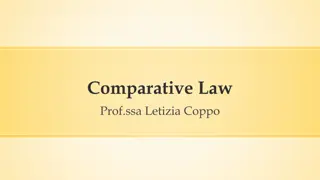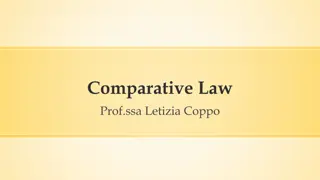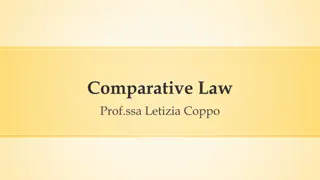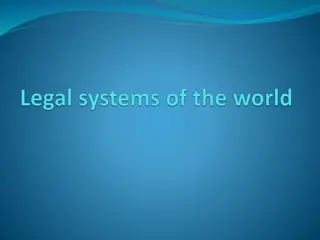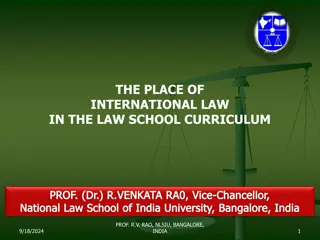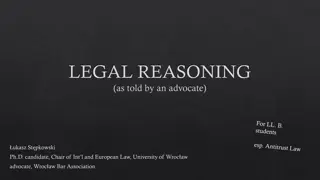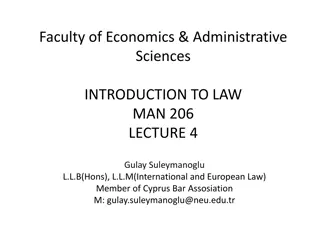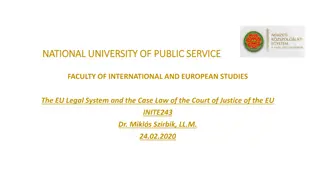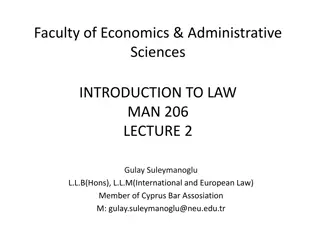Understanding Sources of Law in Legal Systems
Exploring the sources of law, this content delves into the concept of formal and material sources categorized by legal scholars. It examines how legal systems differ in recognizing sources such as precedents, legislation, customs, and treaties. The focus shifts to Indian law, highlighting the significance of the Constitution as a foundational legal source.
Download Presentation

Please find below an Image/Link to download the presentation.
The content on the website is provided AS IS for your information and personal use only. It may not be sold, licensed, or shared on other websites without obtaining consent from the author. Download presentation by click this link. If you encounter any issues during the download, it is possible that the publisher has removed the file from their server.
E N D
Presentation Transcript
Sources of Law By Dr Pramod Kumar
Sources of Law A Source of Law means either the manufacture or origin of a Law or the ability to impart a rule or norm the quality of Law. Source means origin which something is ultimately derived and often refers to the causes operating before the thing itself comes into being. The term sources of law has been used in different senses by different jurists and different views have been expressed from time to time. CK Allen agencies through which the rules of conduct acquire the character of law by becoming definite, uniform and compulsory Vinogradoff process by which the rule of law may be evolved Oppenheimer the name for a historical fact out of which the rules of conduct come into existence and acquire legal force
Classification of Sources of Law Salmond classified the sources of law into two categories: 1. Formal Sources : These are those sources which are recognised as such by the law itself and are authoritative. From these sources, a rule of law derives its force and validity. Thus, the will of the State as manifested in the Constitution, Statutes, Court s decision are the formal sources of law. 2. Material Sources: From these sources, a rule of law derives the matter but not the validity. Material sources of law refer to the various processes, which result in the evolution of the materials, which are the constituents of law.
Classification of Sources of Law Material sources are divided into two categories: 1-Legal Sources:-Unlike legal sources which are sources not only fact but also law and are authoritative. For example:- i. Statute law - having its force in legislations; ii. Case law - having its source in precedents; and iii. Customary law - having its source in customs. 2. Historical Sources:- The historical sources are sources in fact only and are unauthoritative. For example:- (i) Juristic writings; (ii) Literary works; and (iii) Foreign decisions. The decision of the court is a legal source, while the ultimate material on which it is based are historical sources. Legal sources operate directly and immediately, while historical sources operate indirectly and mediately.
Classification of Sources of Law Sources of law differ from system to system and society to society. In common law system, precedents and custom are recognised as the legal sources of law, In civil law countries, legislation, customary law and treaties are often declared to be the only sources of law. In India, we have common law system, Constitution, legislation, precedents and customs are our legal sources of law. In some matters, personal law (Koran, Smrities, etc.) is also a source of law. Constitution, legislation,
Sources of Indian Law The main sources of the Indian law may be summarized as follows: - 1. Constitution:- Constitution differs from legislation in so for as legislation finds its authority in the Constitution while the Constitution is the ultimate source and its authority lies in the political fact that it has been so accepted. A constitution may be the fundamental law of the land or it may simply be a political document. Our Constitution is the fundamental law of the Country. Its provisions lay down binding rules, violation of which can be checked and remedies through court action.
Sources of Indian Law 2. Custom or Customary Law:- Custom is the oldest and most important source of law, its importance is now diminishing with the growth of legislation and precedent. Custom means uniformity of conduct of people under like circumstances. Holland says that custom is a generally observed course of conduct. According to Salmond Custom is the embodiment of those principles which have commanded themselves to the national conscience as principles of justice and public utility . He says that custom embodies those principles as are acknowledged and approved, not by the people of the State but by public opinion of the society at large. According to Herbert Spencer, custom is tradition passing from one generation to another that originally governed human conduct. Keeton defines custom as those rules of human action, establishment by usage and regarded as legally binding by those to whom the rules are applicable, which are adopted by court and applied as a source of law because they are generally followed by the political society as a whole or by some part of it .
Kinds of Custom Custom may be either 1. Conventional or 2. A legal custom. 1. Conventional Custom:- Conventional custom is also called usage , viz certain trade practices. Its authority is conditional on its acceptance and incorporation in the agreement between the parties bound by it. A conventional custom should reasonable and be consistent with the statute law; A usage which is contrary to any express condition laid down in a contract shall not be enforceable by law. A conventional custom may either be local or national/general . Before becoming a part of the law, such customs pass through three stages: i) they should be proved before the court as a question of fact ii) the court takes judicial notice of them and they are established as a precedents, and iii) the custom is embodied in a statute and takes its final shape.
Kinds of Custom 2. Legal Custom:- Legal custom are those which are operative per se as binding rules of law independent of any agreement between the parties. Legal custom are of two kinds: (i) local/special custom: a local custom in India further divided into: (a) Geographical local (limited to a particular locality-town, district, etc.) (b) Personal local (limited to sect of family for example a family custom amongst the members of a particular tribe) (ii) General Custom. A general custom binds all the persons within a community and constitutes one of the sources of the common law of the country. It is treated to be part of the law of the land. It should not be in conflict with the common law or statute law.
Essentials of a Valid Custom In order to be valid and have a binding force as a law, a custom must have the following requisites:- (i) Antiquity: A custom must be in existence from time immemorial. English law fixed the year 1189 to test the antiquity of a custom. A custom must be in existence prior to 1189, only then it can prove the consideration of antiquary. Under Hindu law also immemorial customs are transcendental law. However India law does not fix any particular year to test the antiquity of custom. (ii) Reasonableness: A custom must be reasonable, although it is not necessarily founded on reason. But an unreasonable custom is void and no amount of reasoning would make it valid. Customs differ from place to place. The reasonableness is, therefore, to be determined in context of society in which it exists. There may be certain customs, which are to be held unreasonable in all times and in all societies.
Essential of a Valid Custom (iii) Continuous observance: the custom must have been in use continuously and it should not be vague or indefinite. Its existence must be proved by clear and unambiguous evidence. (iv) Conformity with Statute law and public policy: Custom should be conformity with statute law. A legislative enactment can abrogate a custom. In case of inconsistency between custom and statutory provision, former must give way to the latter. Thus, custom yield legislative enactment. (v) Consistency: A custom must not be in conflict with other prevailing customs. The customs must be in consistency with other custom. Difference or inconsistency in custom will amount to different rule of conduct for a given situation; it will negotiate the general consent. (vi) Obligatory force: Custom must have been enjoyed as a matter of right. This right should be enforceable. Thus custom must result in creating obligatory force at the one hand and related claim on the other hand. If a practice is observed as a courtesy and not as a matter of right then it can be termed a custom in legal sense. (vii) Peaceable enjoyment: It is essential that custom must have been enjoyed peacefully by the concerned people.
Difference between customs and Usage Customs is bound on parties even if there is no express contract between parties and parties cannot deny it, on the other hand, usage will be bound on parties if it is expressively said by the parties. For a custom to be valid it should exist from time immemorial, but it is not in the case of usage. A usage is a repetition of acts whereas custom is the law or general rule that arises from such repetition.
3. Legislation Legislation is the most important and biggest source of law. The term legislation means the making or setting of law. Legislation is the source of law which consists in the declaration of legal rules by a competent authority for example Parliament or State legislatures. Legislation is a deliberate process of legal evolution which consists in the formulation of norms of human conduct in a set form through a prescribed procedure by agencies designated by the Constitution.
Kinds of Legislation Legislation may be of two kinds: 1. Supreme legislation: When the sovereign authority itself makes the law, it is supreme legislation. Supreme legislation is not superior to the Constitution and it is subject to various constitutional limitations. Supreme legislation cannot delegate the essential legislative functions which relate to the making of policy. For example Acts of parliament and the ordinances and other laws made by the president and Governors, is supreme legislation. 2. Subordinate legislation or delegated legislation: Subordinate or delegated legislation is by any other authority than the sovereign, by virtue of powers delegated to it by the sovereign, and subject to control of sovereign. For example rules, regulations, bye-laws, orders, directions, notifications, etc.
4. Precedent In a common law system like ours precedents constitutes a very important source of law. It means the employment of past decisions as guides in the moulding of future decisions. Salmond defines precedent as the making of law by the recognition and application of new rules by the courts themselves in the administration of justice Keeton: A judicial precedent is a judicial decision to which authority has in some measures been attached . The doctrine of precedent provides the evidence of what the law is on a particular time. A judicial precedent may be authoritive(i.e. having a binding forces) or persuasive(i.e. which the judges are under no obligation of following but which they may take into consideration) Persuasive precedents are merely historical sources viz. Foreign Judgments, Judicial Dicta, Authoritative text books and commentaries.
Do Judges Make Law It is a debatable question as to whether judges make law or simply declare an existing one. According to declaratory theory of precedents, judges are merely law finders and not law-makers. Blackstone said that judges did not create any new principles of law through their decisions but simply put a stamp of authority on the already existing principles of law in the society. Coke said that judicial decisions are not source of law but as the proof of what the law is. A number of jurists like Gray, Holmes, Dicey, Salmond and others have proved beyond doubt that judges not only declare law but also make it through their decisions.
Do Judges Make Law Dicey said that the best part of the law of England i.e. common law is judge-made law. Bacon observed that there frequently arises novel cases or case of first impression which the judge has to decide without the assistance of any pre-determined legal rule. The principle laid down by judges in such cases are bound to be a distinct contribution to the existing law.
Do Judges Make Law Constitutional cases decided by the Supreme Court are binding and are law . In Devki Nandan Aggrawal vs. Union of India(AIR 1992 SC 96), the Supreme Court held that the power of judges to interpret statutes is not limited. The court cannot rewrite, recast or reframe the legislation for the very good reason that it has no power to legislation. The Court shall decide what the law is and not what it should be.
Legislation V. Precedent i) The very aim of the legislation is to make law. The main purpose of the precedent is to interpret and to apply the law. ii) A legislation is general and comprehensive. A precedent has none of those merits. iii) A statute can make rules for the future cases which may arise. A Precedent can lay down a rule when a case comes before it. Thus, its emergence depends on litigation. iv) In precedent, rules and principles are laid down by inductive method. In legislation, the deductive method is resorted to. The courts take the rules from the statute and apply it to particular cases.
Doctrine of Stare Decisis Stare decisis is a Latin term. It means to stand by things decided. Stare decisis is a doctrine used in all court cases and with all legal issues. A doctrine is simply a principle, or an instruction, but it's not necessarily a rule that cannot ever be broken. The doctrine of stare decisis means that courts look to past, similar issues to guide their decisions. The past decisions are known as precedent. Precedent is a legal principle or rule that is created by a court decision. This decision becomes an example, or authority, for judges deciding similar issues later. Stare decisis is the doctrine that obligates courts to look to precedent when making their decisions. These two principles allow American law to build case-by-case, and make our legal system a common law system.
Doctrine of Stare Decisis In India, precedents constitute a very important source of law. The Supreme Court in a case observed that the doctrine of stare decisis is a very valuable principle of precedent which cannot be departed from unless there circumstances or special reasons to do so. A High Court whether bound by the decision of another High Court? Supreme Court Whether decision? are extraordinary bound by its own
Ratio decidendi and Obiter dicta The part of that case that is said to posses authority is the ratio decidendi, i.e. the rule of law upon which the decision is founded. The ratio decidendi of the case can be defined as the material facts of the case plus the decision thereon . Obiter Dicta: it refers to the observations made by a court in a particular case. For example Hypothetical facts, illustrations and casual expressions. Judges are not bound to follow them though they can take advantage of the same. The reason for not regarding an obiter dicta as binding is that it was probably made without a full consideration of the cases on the point.







